British Education System by Artem Ipatov РЭУ им.


British Education System by Artem Ipatov РЭУ им. Плеханова ВШСИТИ 190-12

contents Introduction History Present education system Higher education Schools Today
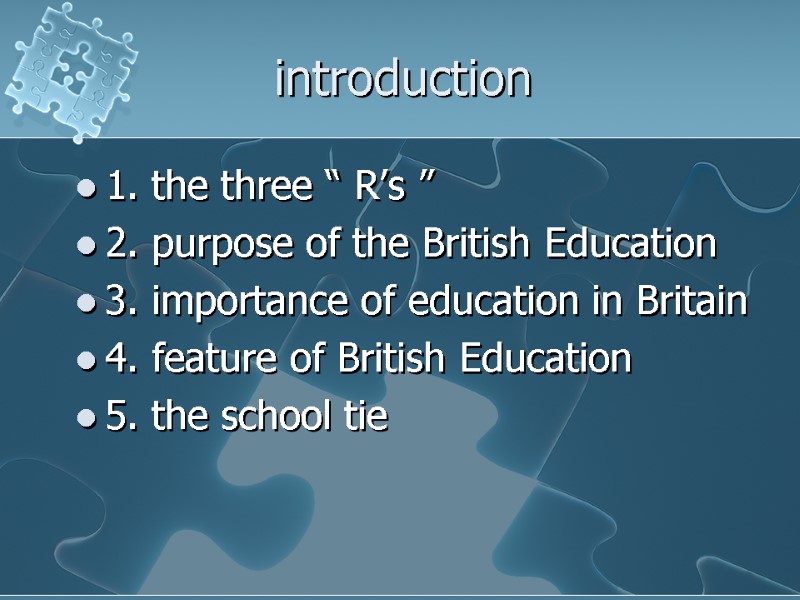
introduction 1. the three “ R’s ” 2. purpose of the British Education 3. importance of education in Britain 4. feature of British Education 5. the school tie

History 1. the form of British education in the past 2. the British education system is run by the state today 3. Some changes to the British education system*

▶Some changes to the British education system: *before 1870, education was voluntary and many of the existing schools had been set up by churches *only 40% of children aged 10 went to school regularly

(1) some caused by the Industrial Revolution ⇒government decided to become involved in taking responsibility for the education of children *in 1870 the government passed a law which called for government-funded education *by 1880, the attendance at school for children between 5 and 10 was compulsory rather than voluntary

(2) Some caused by WWII ⇒the government began planning to reconstruct the education system ①1944 Education Act stipulates that all children were given the right to free secondary education (failed) ②in the 1960s, comprehensive system was introduced into Britain →ended the division between grammar schools and vocational schools →entrance exams were abolished

③the Education Reform Act 1988 provided for the establishment of a National Curriculum for 5-16 year-olds and regular examinations →brought a big change (reintroduced competition between schools)

National Curriculum The national curriculum occupies not less than 70% of the school timetable, the rest of the time being used for subjects of the school’s choosing. There are four key Stages. At each of the stages the core subjects of English, mathematics, science, technology, physical education and religious education are taught. History, geography, music and art are also compulsory subjects up to 16 years old, but they become optional in Key Stage 4. A modern foreign language is added to the curriculum at Key Stages 3 and 4.

The Present Education System 1. Education in the UK is compulsory (from the ages of 5 to 16) 2. State schools and private schools* 3. The schooling stages*

The Present Education System State schools and private schools state schools: funded by local and central government (free) *a system of “league tables” private schools (public schools): receive their funding through the private sector, tuition rates and government assistance
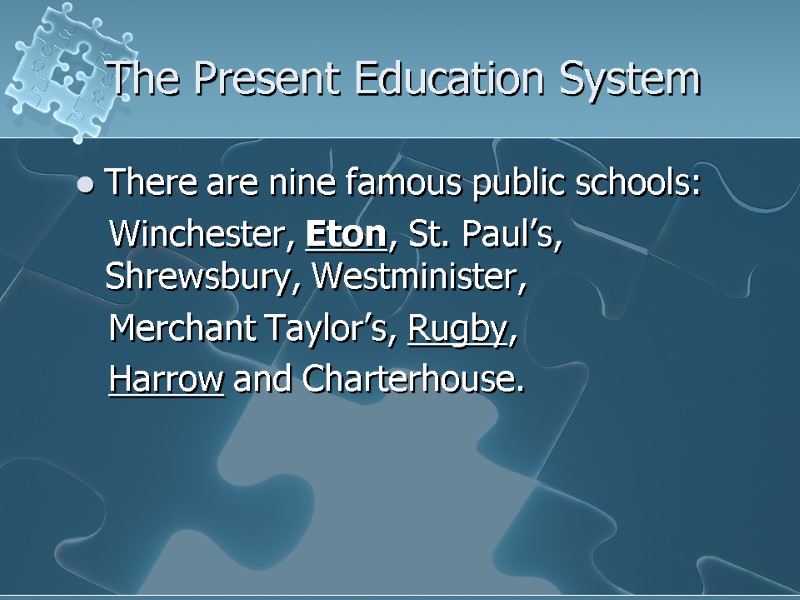
The Present Education System There are nine famous public schools: Winchester, Eton, St. Paul’s, Shrewsbury, Westminister, Merchant Taylor’s, Rugby, Harrow and Charterhouse.
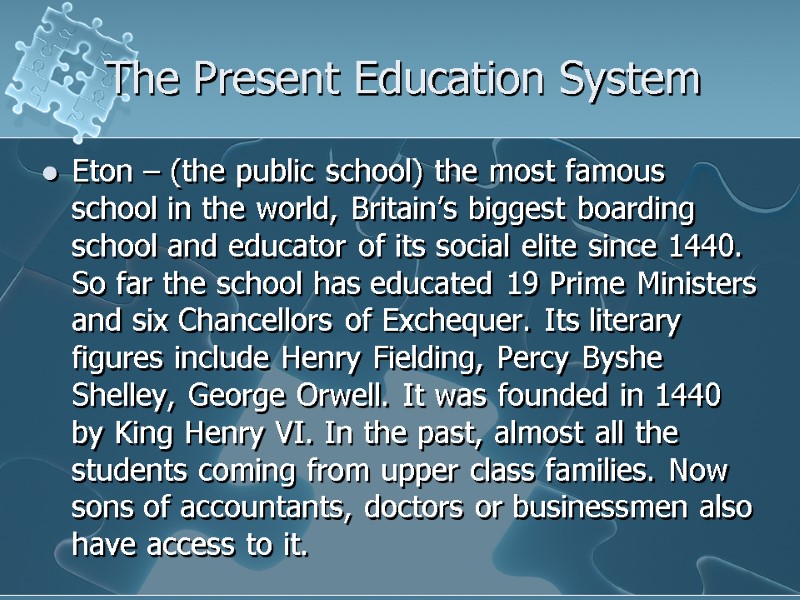
The Present Education System Eton – (the public school) the most famous school in the world, Britain’s biggest boarding school and educator of its social elite since 1440. So far the school has educated 19 Prime Ministers and six Chancellors of Exchequer. Its literary figures include Henry Fielding, Percy Byshe Shelley, George Orwell. It was founded in 1440 by King Henry VI. In the past, almost all the students coming from upper class families. Now sons of accountants, doctors or businessmen also have access to it.

Eton College is located in the town Eton which is an urban district of southeast-central England on the Thames River

Eton is a public school for boys age 13-18. Almost all the pupils go on to study A levels, 90% will go on to university, a quarter to Oxford and Cambridge. The pupil/teacher ration is 9.5 to one, while in state secondary school the ratio is 20 to one.

School yard

The facilities include purpose-built theatres, libraries, swimming pools, even a golf course.
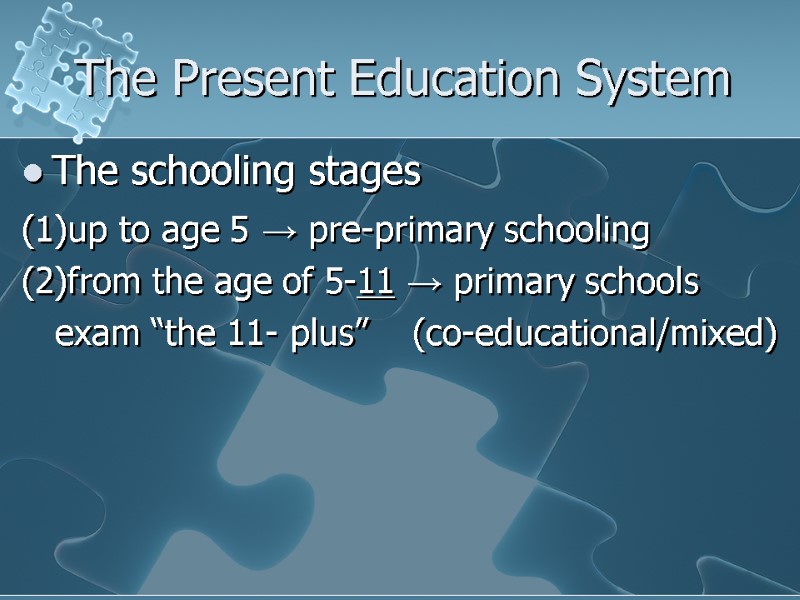
The Present Education System The schooling stages (1)up to age 5 → pre-primary schooling (2)from the age of 5-11 → primary schools exam “the 11- plus” (co-educational/mixed)

Class teacher system in primary schools In order to give young children a sustained contact with one teacher, usually one teacher is responsible for organizing the whole day’s lessons and have to teach all the subjects.

The Present Education System (3)age of 11-19 → secondary schools (comprehensive/grammar) ①age of 16 → GCSE exams (some choices) ②age of 18 or 19 → A-levels exams (after 2 years in the Sixth Form) go to university / if not, take vacational training (GNVQs)

The General Certificate of Secondary Education is taken at the end of compulsory education at the age of 16. All the students are required to take it.The results often help the students and their parents to made a choice whether they will go to college or not. GCSE

GCE A level About 70% of 16 year old pupils choose to continue in full-time education. Some students continue in the same school for a further two years of study in the ‘sixth form’. After two-year study, three or four subjects are taken in the examination of the General Certificate of Education- Advanced level (GCE A level). The grades obtained in GCE A level are the main basis whether the students can go to college or not.

Higher education and training in UK 1. Nearly all universities are public bodies 2. Higher education has a long history in the UK 3. The general condition of university students 4. Degrees* 5. Leading universities in UK* 6. Open university and further education*

Degrees awarded Bachelor of Arts (BA) or Bachelor of Science (BSc) – after three years of full-time study. Master of Arts (MA) or Master of Science (MSc) after a further one year full-time or two year part-time study. Doctor of Philosophy (PhD) – after at least three years of original research.

Leading universities in UK The Guardian University Guide, 2003

Cambridge University, Cambridge, east-central England

The first college Opened in some 1200s. the oldest Building dating back to 1284.


Oxford university, Oxford, northwest of London
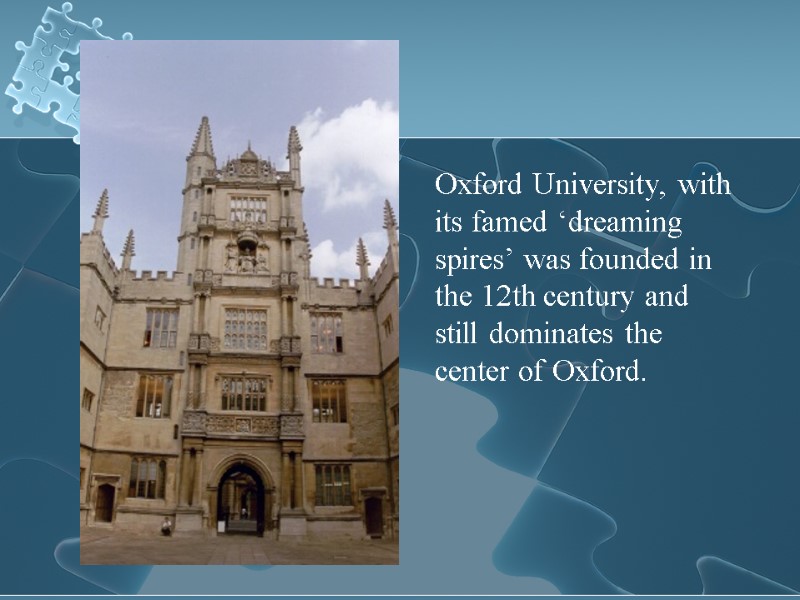
Oxford University, with its famed ‘dreaming spires’ was founded in the 12th century and still dominates the center of Oxford.

Museum of Natural History, Oxford university
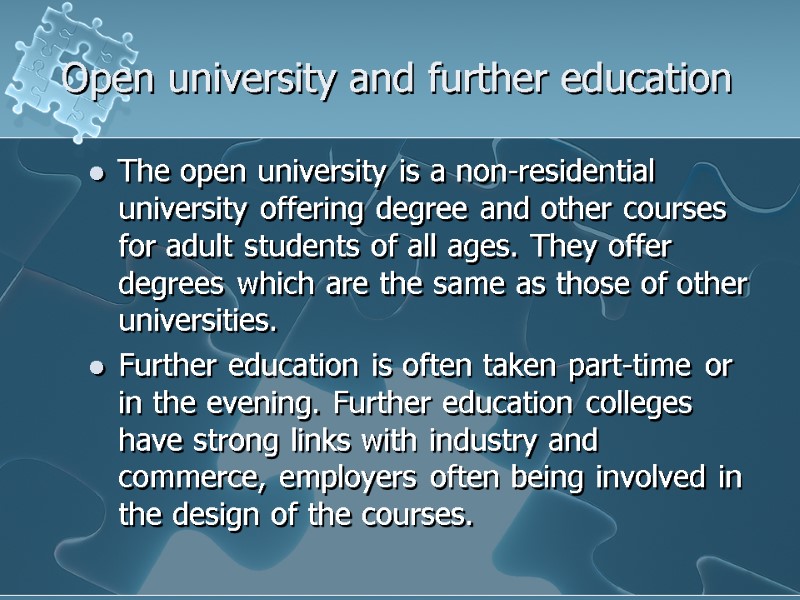
Open university and further education The open university is a non-residential university offering degree and other courses for adult students of all ages. They offer degrees which are the same as those of other universities. Further education is often taken part-time or in the evening. Further education colleges have strong links with industry and commerce, employers often being involved in the design of the courses.



Schools Today Primary schools Compulsory schooling starts at 5 Co-educational and a class-teacher system Three-term school year Secondary schools Compulsory schooling extends up to 16 The selective system, comprehensive system and independent schools Sixth form colleges/ tertiary colleges Other schools County schools Voluntary schools

The Selective System A system for secondary schooling in Britain, under which children take an examination, the “11 plus”, in their last year of primary education. The results of the examination determine the kind of secondary schooling each child will receive. Those with the highest marks go to grammar schools; others may go to technical schools, and the rest – by far majority – go to secondary modern schools.

The Comprehensive System A system for secondary schooling in Britain, under which all children, regardless of ability, can mix together. In comprehensive schools, students study a wide variety of subjects at first until 2 or 3 years later, when they may study only those they like best. Many new ideas in education are being tried out at present, and comprehensive schools vary widely throughout Britain.

Independent Schools Public schools: secondary private boarding schools that prepare students chiefly for universities. They laid the foundations of English education, but now are generally restricted to a comparatively small section of the population, mainly the rich and conservative in politics. Eton, Harrow and Rugby are the 3 most famous public schools.

Independent Schools Prep schools: small private boarding schools for children up to 7 or 8 years old, which help to prepare the children for the “common entrance” examination at the age of 13 for admission to a public school, and where Latin, French and mathematics are all started early.

Other Schools County schools: state-run secondary schools, most of which are administered by the county or county borough. About half of the money comes from the local authority and the other half from the central government. Voluntary schools: also called mission schools in other countries, secondary schools in Britain that are mostly Church of England or Roman Catholic in origin, and partly maintained and controlled by the local authority. They give a certain amount of denominational religious instruction. Education is free in such schools.

“Red Brick” “Red brick”:The Redbrick Universities include all the provincial universities of the period 1850-1930 as well as London University. Because the favorite building material of the period between 1850-1930 is red brick, and all the universities of the time were built in red brick. Thus, they were called the Redbrick Universities.

“Red brick”: a slightly contemptuous term used to refer to the large group of 19th- and 20th-century universities and university colleges in Britain. It describes their construction, which is contrasted with the more dignified and solid-looking ancient architecture of Oxford and Cambridge. The distinctive feature of these universities was that they were non-collegiate institutions which admitted men without reference to religion or background and that they concentrated on 'real-world' skills, often linked to engineering.



9918-i7.ppt
- Количество слайдов: 45

